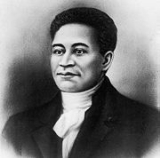
who have at least partial ancestry from any of the native populations of Sub-Saharan Africa
and are the direct descendants of enslaved Africans within the boundaries of the present United States. Most African Americans are of West Africa
n descent. However, some immigrants
from African, Caribbean, Central American or South American nations, or their descendants, may also self-identify with the term.
African Americans make up the single largest racial minority in the United States.
African-American history starts in the 16th century with African slaves who quickly rose up against the Spanish explorer
Lucas Vásquez de Ayllón
and progresses to the present day, when Barack Obama
has been elected as the 44th and current President of the United States
.
1820 The first 86 African American immigrants sponsored by the American Colonization Society started a settlement in present-day Liberia.
1863 American Civil War: The 54th Massachusetts Volunteer Infantry, the first African American regiment, leaves Boston, Massachusetts, to fight for the Union.
1864 American Civil War: The Fort Pillow massacre: Confederate forces kill most of the African American soldiers that surrendered at Fort Pillow, Tennessee.
1865 American Civil War: The Confederate States of America agree to the use of African American troops.
1867 African American men are granted the right to vote in Washington, D.C.
1868 The 14th Amendment to the United States Constitution is ratified guaranteeing African Americans full citizenship and all persons in the United States due process of law.
1870 Hiram Rhodes Revels, a Republican from Mississippi, is sworn into the United States Senate, becoming the first African American ever to sit in the U.S. Congress.
1877 Henry Ossian Flipper becomes the first African American cadet to graduate from the United States Military Academy.
1892 The New Orleans general strike begins, uniting black and white American trade unionists in a successful four-day general strike action for the first time.
1900 American Civil War: Sergeant William Harvey Carney becomes the first African American to be awarded the Medal of Honor, for his heroism in the Assault on the Battery Wagner in 1863.
I am America. I am the part you won't recognize. But get used to me. Black, confident, cocky; my name, not yours; my religion, not yours; my goals, my own; get used to me.![]()
The common goal of 22 million Afro-Americans is respect as human beings, the God-given right to be a human being. Our common goal is to obtain the human rights that America has been denying us. We can never get civil rights in America until our human rights are first restored. We will never be recognized as citizens there until we are first recognized as humans. ![]()
If we accept and acquiesce in the face of discrimination, we accept the responsibility ourselves and allow those responsible to salve their conscience by believing that they have our acceptance and concurrence. We should, therefore, protest openly everything . . . that smacks of discrimination or slander. ![]()
My father was a slave and my people died to build this country, and I'm going to stay right here and have a part of it, just like you. And no fascist-minded people like you will drive me from it. Is that clear? ![]()
The workings of the human heart are the profoundest mystery of the universe. One moment they make us despair of our kind, and the next we see in them the reflection of the divine image. ![]()
It is a peculiar sensation, this double-consciousness, this sense of always looking at one's self through the eyes of others. . . . One ever feels his twoness,—an American, a Negro; two souls, two thoughts, two unreconciled strivings; two warrings ideals in one dark body, whose dogged strength alone keeps it from being torn asunder.![]()
We have come over a way that with tears has been watered, We have come, treading our path through the blood of the slaughtered. ![]()
Freedom is never given; it is won. ![]()

